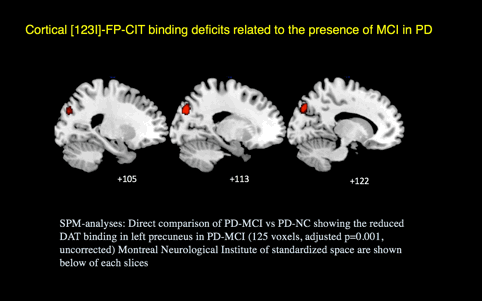Session Information
Date: Monday, October 8, 2018
Session Title: Parkinson's Disease: Cognition
Session Time: 1:15pm-2:45pm
Location: Hall 3FG
Objective: The objective of the study was to evaluate the relationship between basal ganglia and cortical 123I-FP-CIT binding and early cognitive deficits in PD.
Background: Severe deficits within dopaminergic striatal binding have been associated with early progression to dementia in Parkinson’s disease (PD). The correlation between stratal and extrastriatal binding and deficits within specific cognitive domains are still theme of debate.
Methods: sixty-seven PD patients (mean age 67.6 + 10.7 years, mean disease duration 5.1 + 4.2 years) entered the study and underwent DaTSCAN imaging. An extensive neuropsychological evaluation (level II MDS definition) was performed, allowing the classification of patients into 33 with normal cognition (PDNC) and 34 with mild cognitive impairment (PD-MCI). The striatal tracer uptake was evaluated using BRASS software (Hermes, Sweden). The correlation between deficits within performances in specific neuropsychological tests and striatal dopaminergic binding were evaluated by multiple regression analyses. The whole-brain analysis was performed with Statistical Parametric Mapping (SPM). All the analyses were adjusted for the effect of age, sex, disease duration and presence of impulsive-compulsive disorders.
Results: No significant striatal binding differences were found between PD-MCI and PDNC patients by using adjusted BRASS analyses. Right caudate and right putamen binding correlated with MMSE and verbal fluency scores, respectively. PD-MCI patients showed a significant reduction of left precuneus tracer uptake compared to PD-NC (125 voxels, adjusted p=0.001, uncorrected, Figure 1).
Conclusions: the development of cognitive deficits in PD may be related to early cortical 123I-FP-CIT reduction, even in absence of any difference in striatal binding. This might reflect a selective damage in PD-MCI of precuneus, classically impaired in early Alzheimer’s disease. Alternatively, this might be secondary to a disconnection of bioaminergic striato-cortical projections. Multi-modal imaging and longitudinal studies are warranted in order to clarify this issue.
To cite this abstract in AMA style:
A. Pilotto, F. Schiano DiCola, E. Premi, V. Garibotto, A. Scalvini, R. Turrone, R. Grasso, B. Bigni, S. Gipponi, B. Paghera, MC. Rizzetti, b. Borroni, A. Padovani. Subcortical and Cortical 123I-FP-CIT binding deficits and mild cognitive impairment in Parkinson’s disease [abstract]. Mov Disord. 2018; 33 (suppl 2). https://www.mdsabstracts.org/abstract/subcortical-and-cortical-123i-fp-cit-binding-deficits-and-mild-cognitive-impairment-in-parkinsons-disease/. Accessed June 30, 2025.« Back to 2018 International Congress
MDS Abstracts - https://www.mdsabstracts.org/abstract/subcortical-and-cortical-123i-fp-cit-binding-deficits-and-mild-cognitive-impairment-in-parkinsons-disease/

